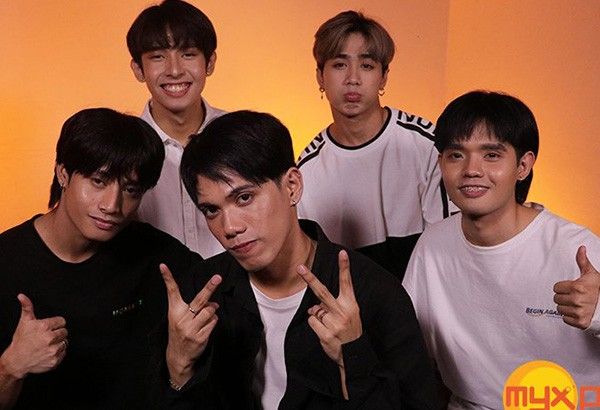The ‘idols’ fight back: SB19, visuals and identity

MANILA, Philippines — It is common to hear people bash artists for how they look. What is less common, however, is for fans to be critical of their idols’ so-called visuals. One such fan of SB19, a phenomenal boy group from the Philippines, has recently learned what it means when their "idols" fight back.
The fan, in a seemingly guarded tweet, admitted that while "she" (the stan account says so) believes in their talents, two of the five members do not fit her own standard of a good visual.
But this is 2020, she said, so surgery would now be an option.
The tweet unsurprisingly generated a ferocious response from other fans of the group, called the A’Tin, defending the two boys’ visuals. Notice here how the response in general fell into the discourse trap of visual talk – defending criticisms of looks while justifying the looks on grounds that beauty is in the eye of the beholder. The talking points of the conversation remain committed to highlighting the primacy of visuals and skin color in "idol culture."
Stell, one of the two members concerned, responded to the tweet. It was, I believe, a gentle but pained response, explaining that he himself does not think he is handsome, but he believes in his talent and that’s all that matters. Notice again here how Stell fell into the same trap of visual talk, reminding us again that it is not easy to change the talking points about "idols" today.
But Stell went one step further. He blocked the account. "Is this what an idol is?," asked the fan before electing to leave the fandom.
Several days later, it was Sejun’s turn to address the tweet. His response, however, framed it as a much larger issue, in fact surfacing the core political and ideological foundations of idol culture today. He does not want to be called an idol, he says, because he does not intend to be one. He is who he is, wearing his "garbage all the time," thus making him feel good and bad about it at the same time. He tries “to keep an open mind," and I do think this refers to how he has consented to doing things to please the fans but without compromising his own principles. What is important is for him “to be a better person, so don’t ever give me that 'it’s already 2020' BS'."
Since he was born, “I AM STILL ME, NOTHING CHANGED."
They fought back
What is fascinating about this series of tweets is that it was primarily a response to a specific fan tweet, making it decidedly personal and anguished. This was not a basher, an outsider, who could easily be ignored. This was a fan with a few hundred A’Tin followers on twitter, professing love for SB19 and admiring them for their talents and personalities.
The content, however, was likewise decidedly all-encompassing, taking the bulls by the horns by addressing the toxic idol culture directly. In other words, Sejun’s series of tweets, including Stell’s decision to block the account (perhaps mainly to silence the voice or opinion that he thought hurts others), took control of the narrative about visuals and identity.
They fought back.
But it is naïve to believe that they have taken control of the narrative completely. Not at all. The struggle to break free from the symbolic violence of visual talk, especially one that is fixated on impressionistic consumption of the body, is real. Even among some A’Tin themselves, defending the boys’ visuals is through highlighting their visuals as well. The toxic discourses on "pogi" and "panget," especially if they are drawn upon to justify the quality or worthiness of certain artists, are implicated in daily conversations in the fandom.
Nevertheless, the pushback is real. We cannot underestimate its impact on silencing loud voices which demand that SB19 fit into the idealized notion of what it means to be an idol today – visually appealing, perfect in all ways. After all, “Part of an idol’s currency is looks and a glossy, highly produced MV [music video] amplifies that," said @happy14geek.
Young fans complain about being distressed by comments coming from their own parents, siblings or close friends. They have a nuanced take on the phenomenal rise of SB19 – it is a combination of talent and personality – but all that is cancelled by a brutal remark, "Ang papanget nila."
We have lived and continue to live through a culture which privileges the aesthetic or the beautiful (whatever this means) as the norm for valuing what is desirable or not. Imagine a young child growing up in an environment which reduces all talk about worthiness to good looks.
SB19’s phenomenal rise is a counter-narrative
What Stell and Sejun have done in their most recent engagement with this issue is not to simply to unframe the idea of an "idol" from its toxic meanings and practices, but to send the message that as much as they are shaped by the idol culture within which they work and live, they are also actively engaged in creating and shaping their own identities. This is clearly easier said than done, but one thing that needs to be emphasized is that the phenomenon of SB19 is by itself a discursive negotiation of idol culture and a story of how it has slowly navigated this culture in order to live it while transforming it.
When SB19’s Go Up Dance Practice became viral on September 2, 2019, there was one consistent narrative emerging from the ground. They were an embodiment of "talent over looks," a victim of the unfortunate fixation on the primacy of looks (mestizo, for example) which big players in the industry would continue to capitalize on when grooming future artists. Along with their viral video came their vlogs and their interviews which slowly consolidated a counter-narrative which drew attention to the importance of hardwork, talent and personality.
Idol culture, however, is brutal, as its core assumptions are deeply ingrained in people’s lives, minds and practices. In interviews, they were asked consistently about their looks, even insinuating their gender preferences even by the color of their hair and the way they move – "parang bakla talaga."
Josh turned this around and redirected the conversation toward their dream of inspiring a new generation of Filipinos through their new music – "push lang po ng push tapos huwag lang po tayo mawawalan ng pagasa."
Justin, being the main visual of the group, was asked point blank what he felt about being responsible for the future success of the group. He also turned this around and said, "Nagtutulungan po kami."
This sort of a question, especially coming from industry players like entertainment writers, is not only insulting to the rest of the group. In fact, it is insulting to Justin whose worth is reduced to his looks. If at all he has contributed to the success of the group, it is because he is a multitalented young Filipino artist. He wrote the story line and directed the group’s animated music video of their single, "Hanggang sa Huli." He is a multimedia visual artist who knows how to paint, draw and sketch, and does so competently.
It is the same story with Ken. In his responses to similar questions, and even in the lyrics of his unreleased songs, he is consistent with his pushback: "Say what you want about my looks. I don’t care. But talent? Confident ako diyan." The problem with the "visual" card is not so much that it is irrelevant – the use of "visual" over ‘"looks" in recent years signals the shift towards technologically-mediated representation as identity-making -- but in everyday use it strips people of everything else they have.
"Ang papanget."
It is painful to hear this from parents of "depressed: (their word) young teenagers. It is painful hearing anyone dismiss others with these words. People in positions of power use these words to silence others, and not because they are winning the argument.
I am glad the boys of SB19 are fighting this culture of mediocrity, and the fans are fighting with them: “If you stan just for visuals get out! they deserved to be recognized for their talents and hardwork not just their faces," said @Nikka_Colina25.
This is not easy. The privileging of looks is at the core of many people’s mental and cultural frames of seeing the world and judging people. It is also exploited by a multi-billion global industry which promotes worship of amplified bodies and glossy appearances.
SB19, let us admit it, is also driven by profit. But in a world which is fiercely dead set on perpetuating dangerous stereotypes and beliefs, fighting back is a responsibility. Stan people who fight these microaggressions of everyday life. And better yet, join the fight.
About the writer
Ruanni Tupas (???????? ????????) lives with his wife and three kids in London. He is a leading Filipino scholar of English language and multilingualism who lectures at the Department of Communication, Culture and Media, Institute of Education, University College London. He is an Associate Editor of the International Journal of the Sociology of Language, sole editor of "Unequal Englishes: The Politics of Englishes Today" (Palgrave MacMillan, 2015), and co-editor of several volumes, including "Language, education and nation-building: Assimilation and shift in Southeast Asia" (Palgrave MacMillan, 2014).
RELATED: Buwan ng Wika: Filipino scholar analyzes SB19 Ken Suson, P-Pop as multilingual genre
- Latest
- Trending

































